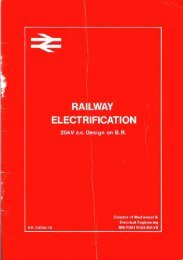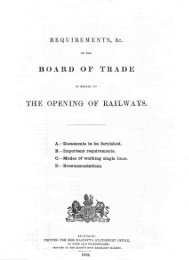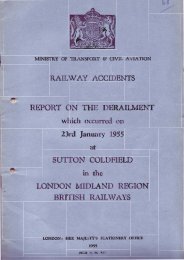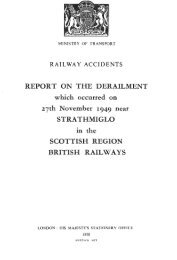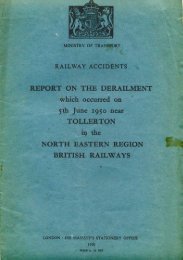R A I LT R AC K - The Railways Archive
R A I LT R AC K - The Railways Archive
R A I LT R AC K - The Railways Archive
Create successful ePaper yourself
Turn your PDF publications into a flip-book with our unique Google optimized e-Paper software.
introduction<br />
We are keen to<br />
have stronger volume<br />
incentives... either<br />
through revenue<br />
sharing... or an<br />
incentives element<br />
within track access<br />
charges<br />
16<br />
1.5<br />
1.5 Economic incentives framework<br />
Our income is derived from a number of sources:track<br />
access charges paid by train operators,stations and depots<br />
access charges, and property rentals and disposals.<br />
We operate under a single-till arrangement.Under this,<br />
the Rail Regulator calculates an overall total revenue<br />
requirement for the Control Period.From this is deducted<br />
expected income from freight and property to give a<br />
revenue requirement from passenger franchise operators.<br />
This is then divided between track access charges and<br />
station charges.<br />
<strong>The</strong> effect of the single till is to allow income from<br />
property and other non-franchise sources to reduce the<br />
amount that needs to be raised from passenger franchise<br />
operators for using the network.Because the Government<br />
provides financial support to franchise train operators,the<br />
effect of the single till is to reduce the amount of<br />
Government subsidy required.<br />
<strong>The</strong> relative magnitude of the different components<br />
of Railtrack’s income is shown below:<br />
Components of Railtrack’s income<br />
Source:Railtrack’ s Annual Accounts 1997/98<br />
Other 2%<br />
P r o p e rty 5%<br />
Freight 7%<br />
F ranchise passenger<br />
o p e ra t o rs 86%<br />
Government support to passenger franchise operators is<br />
expected to fall from £1.6bn (1998/99) to £900M<br />
(in 2003/04).Over this period,most long-distance train<br />
operators are expected to become profitable and then pay<br />
contributions to the Franchising Director. Almost all of the<br />
remaining subsidy will be directed at services in Scotland,<br />
Wales and the English regions including the Passenger<br />
Transport Executive (PTE) areas,with that in Scotland under<br />
the aegis of the devolved Parliament.<br />
<strong>The</strong> current framework of access charges was<br />
established at a time when there was little expectation of<br />
traffic growth.It is ill-suited to the situation that the industry<br />
now faces.While train operators have strong financial<br />
incentives to grow traffic volumes, we currently receive little<br />
benefit from traffic growth on the network because 91% of<br />
track access income is fixed.Recent work suggests that a<br />
much higher proportion of our usage costs,both passenger<br />
and freight,vary with traffic volume, suggesting figures<br />
broadly in line with a recent European Union study across all<br />
member states. We are now exploring the implications of<br />
this with our customers and the Rail Regulator. In this<br />
Statement we assume that our charges in the next Control<br />
Period are set at a level that at least covers our marginal<br />
costs.In addition, we are keen to have stronger volume<br />
incentives – either through specific revenue sharing<br />
arrangements with train operators,or through an incentives<br />
element within track access charges.<br />
Subsidy to the rail industry is declining<br />
Subsidies to rail industry (£M)<br />
2000<br />
1500<br />
1000<br />
500<br />
1998/99<br />
However, our ability to invest depends ultimately on the<br />
financial framework which is set out by the Rail Regulator. In<br />
his December document*,he set out the challenge for us –<br />
whether we wanted to be a low-risk utility essentially acting<br />
as a contractor for Government or the Shadow Strategic<br />
Rail Authority, or a commercial organisation willing to take<br />
demand risk through innovative approaches to networ k<br />
development.<br />
1999/2000<br />
2000/01<br />
2001/02<br />
2002/03<br />
*<strong>The</strong> periodic review of Railtra c k ’s access charg e s :the Rail Regulator’s<br />
conclusions on the Financial Fra m e wo rk (Third Paper) December 1998.<br />
2003/04



